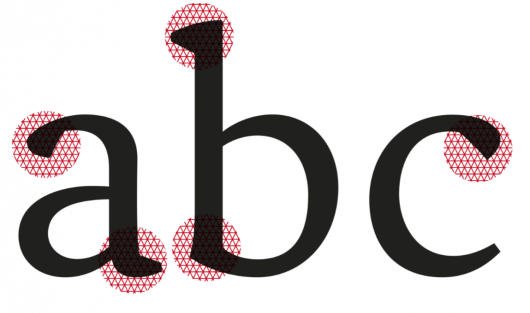 In the light of this project she was granted a scholarship by Microsoft Corporation USA ClearType & Avanced Reading Technologies. At the moment she works as a research assistant at MAD (Media Arts and Design)-faculty, ready to set up more legibility research. Since 2006 she teaches graphic design and typography at the MAD-faculty to bachelor and master students. Ann Bessemans also works as a graphic designer, e.g. for the series of monographs Vlees & Beton/Voids & Borders published by the department of Architecture and Urban Planning of the University of Ghent. She has presented papers and gave workshops on several occasions both in Belgium and abroad. Her research interests include the interrelations between image & word, typography, font design, legibility, reading graphic design, book design and modular systems. Her talk “Matilda, a research based font for improving reading” will take place on Friday at 7 pm in the TYPO Hall.
In the light of this project she was granted a scholarship by Microsoft Corporation USA ClearType & Avanced Reading Technologies. At the moment she works as a research assistant at MAD (Media Arts and Design)-faculty, ready to set up more legibility research. Since 2006 she teaches graphic design and typography at the MAD-faculty to bachelor and master students. Ann Bessemans also works as a graphic designer, e.g. for the series of monographs Vlees & Beton/Voids & Borders published by the department of Architecture and Urban Planning of the University of Ghent. She has presented papers and gave workshops on several occasions both in Belgium and abroad. Her research interests include the interrelations between image & word, typography, font design, legibility, reading graphic design, book design and modular systems. Her talk “Matilda, a research based font for improving reading” will take place on Friday at 7 pm in the TYPO Hall.
1. Which work are you particularly proud of? Which work best represents your style or approach?
I am a graphic designer and I studied design only in my higher education, but for my PhD I came across other scientific fields. In some ways it is nice to challenge yourself by integrating different points of view into design research, and to not just become a complacent designer. Staying critical in the creative process seems to be my approach of design. Furthermore I do believe that design is not some kind of job, but a way of living. Meaning that you have a great passion for design in all aspects.
Although my PhD project doesn’t reflect my graphic style, my type design and the layout of the PhD does, as well as my other graphic work (mainly book design). My style can be described as minimal with an edge (a raw side), truthful, humorous and considered. I play with textures and forms and try to innovate my own graphic world constantly.

2. We chose “Touch” as the theme for this year’s TYPO Berlin. In your opinion, what qualities does design need to have to touch people’s lives? Can you name an example for for design work that had this effect on you?
Graphic design tries to improve our world. There are typefaces that make reading more comfortable (for example the newspaper typefaces from Unger); other typefaces are very expressive to match a brand or a quote (typefaces of Ale Paul) (legibility versus recognizability). In book design and datavisualisation it’s about navigation, hierarchy, structure and tactile aspects to bring over the information in a better, comprehensive and faster way (Munari, Tschichold). Design in all aspects can also match (visualize) feelings or music (CD covers designed by HiorthØy). Design can touch people in different ways.
In addition to the possibility for design to improve our life, it can also touch one as a person when there is an aesthetic experience meaning that horizons of designing and looking are melting together

Ann Bessemans
3. Is there someone you always have wanted to get in touch with, but so far haven’t? Who do you especially look forward to getting in touch with at TYPO Berlin?
Adrian Frutiger. I had briefly contact with him, via (written) mail (send by the postman). I like his type designs but also his drawings are very powerful.
I’m lucky to already have met some speakers. They are wonderful persons and I’m looking forward to meet them again. It is always nice to meet new people during a conference. But I would like to meet Erik Spiekermann, Anthony Burrill, Kate Moross, Martina Flor and Giuseppe Salerno, Van Bo Le-Mentzel Jessica Walsh and the colleagues of my friend Roland Stieger.
4. Required reading/watching: What are currently your favorite interesting/beautiful publications, exhibitions, books, TV-shows, movies, apps and/or websites?
I like all of my books (and there are lots of them!). I adore (graphic/type) design, art, architecture, fashion and product design in general. I cannot say that I have favorites currently. I do not like to follow trends, but I don’t want to be an outsider either. I’m convinced that you need to know what the trends are, so that you are informed and know where your work fits in. I try to push myself to explore new ways of seeing and thinking, hoping that my work is still relevant in the future. For gaining new ideas for a design, I don’t explicitly look at designers websites and design magazines, I rather go to the library or go for a walk with my dog instead.



















